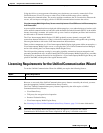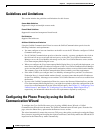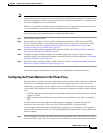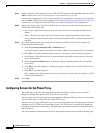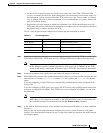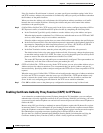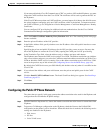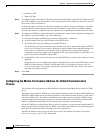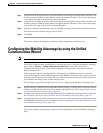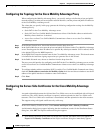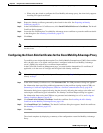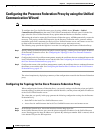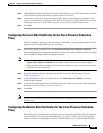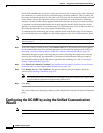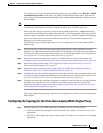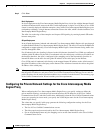
8-11
ASDM configuration guide
Chapter 8 Using the Cisco Unified Communication Wizard
Configuring the Mobility Advantage by using the Unified Communication Wizard
Step 1 In the field for the private IP address, enter the IP address on which private media traffic terminates. The
IP address must be within the same subnet as the private interface IP address. The correct subnet range
is provided to the right of the field for the private IP address.
Step 2 In the field for the public IP address, enter the IP address on which public media traffic terminates. The
IP address must be within the same subnet as the public interface IP address. The correct subnet range
is provided to the right of the field for the public IP address.
Step 3 Specify the minimum and maximum values for the RTP port range for the media termination instance.
Port values must be within the range of 1024 to 65535.
Step 4 Click Next.
The wizard completes by displaying a summary of the configuration created for proxy.
Configuring the Mobility Advantage by using the Unified
Communication Wizard
Note The Unified Communication Wizard is supported for the ASA version 8.3(1) and later.
The Unified Communication wizard guides you through the steps to configure the Mobility Advantage
proxy. Choose Wizards > Unified Communication Wizard from the menu. The Unified
Communication Wizard opens. Click the Cisco Mobility Advantage Proxy radio button under the
Remote Access section.
When using the wizard to create the Mobility Advantage proxy, ASDM automatically creates the
necessary TLS proxies, enables MMP inspection for the Mobility Advantage traffic, generates address
translation (NAT) statements, and creates the access rules that are necessary to allow traffic between the
Cisco Mobility Advantage server and the mobility clients.
The following steps provide the high-level overview for configuring the Mobility Advantage proxy:
Step 1 Specify settings to define the private and public network topology, such the public and private network
interfaces, and the IP addresses of the Cisco Mobility Advantage server. See Configuring the Topology
for the Cisco Mobility Advantage Proxy, page 8-12.
Step 2 Configure the certificates that are exchanged between the Cisco Mobility Advantage server and the ASA.
See Configuring the Server-Side Certificates for the Cisco Mobility Advantage Proxy, page 8-12.
Step 3 Configure the client-side certificate management, namely the certificates that are exchanged between the
Unified Mobile Communicator clients and the ASA. See Configuring the Client-Side Certificates for the
Cisco Mobility Advantage Proxy, page 8-13.
The wizard completes by displaying a summary of the configuration created for Mobility Advantage
Proxy.



